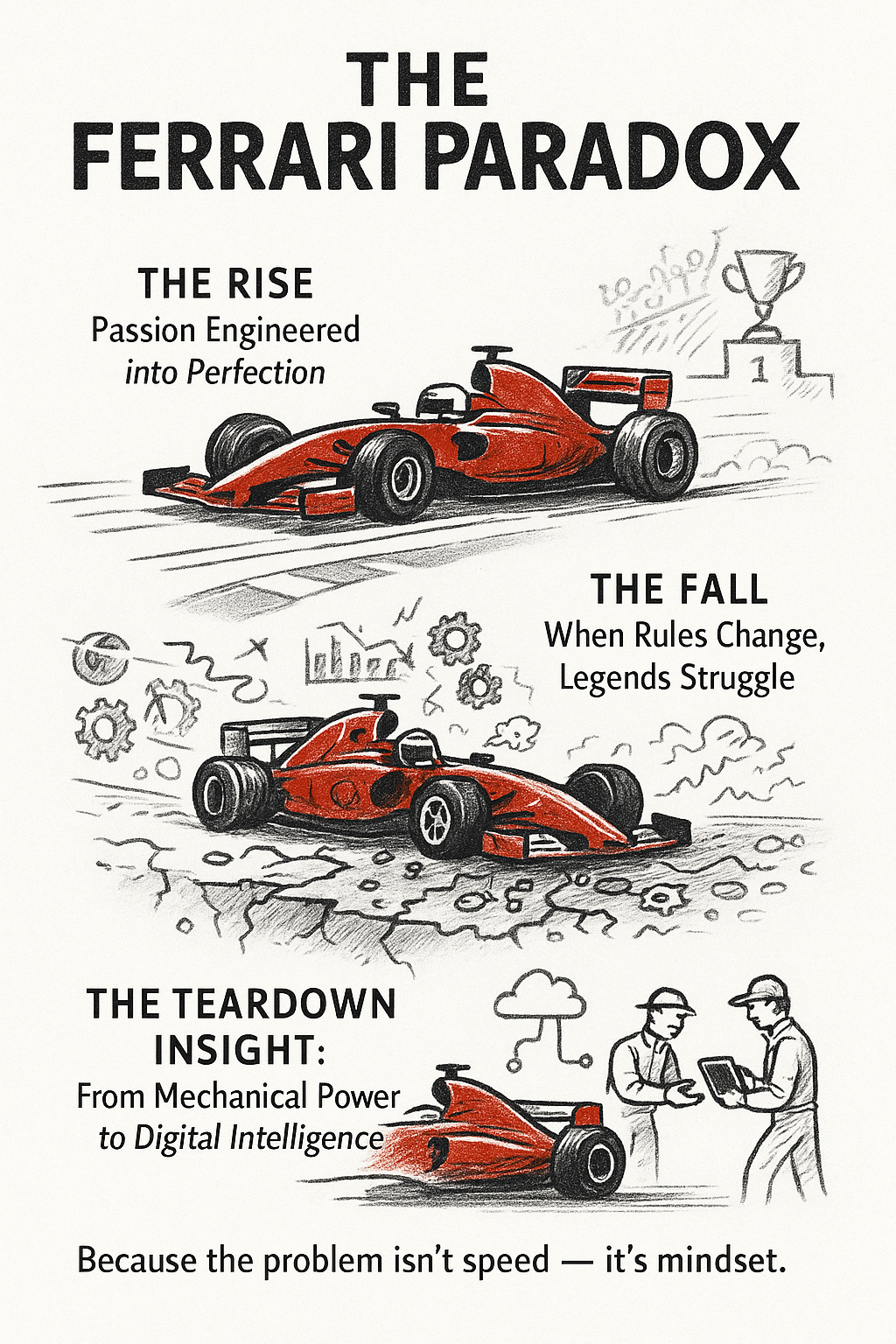The Ferrari Paradox: When Legends Fall from Grace
Ferrari’s fall from dominance isn’t a failure, its a case study in transformation. This product teardown explores how the legendary F1 team lost its edge & what it can learn from digital disruptors.
So, this just happened over the weekend in Singapore. I have to admit, I’ve always been a Lewis Hamilton fan (unapologetically so), and since his move to Ferrari this year, I’ve found myself cheering for the prancing horse.
Yes, I know. It’s a long shot. Ferrari hasn’t exactly been setting the tracks on fire for the past 18 years. But that’s precisely what got me thinking: how did the most celebrated Formula One constructor in history fall from the pinnacle of dominance to a symbol of nostalgia?
That question led me down a rabbit hole, or rather, a pit lane.
What if we ran a product teardown on Ferrari? Not as a car, but as a business system?
What would we uncover if Ferrari had approached its racing strategy the same way great digital companies approach growth by being agile, data-driven, and obsessed with learning loops?
There’s no right or wrong here. Just a frustrated fan wondering whether Lewis Hamilton can squeeze one more championship out of a legendary but stubborn machine.
Because sometimes, what’s broken isn’t the engine. It’s the mindset driving it.
1. The Rise of a Legend: Ferrari’s Golden Age
Every brand has a creation myth. For Ferrari, it was passion engineered into perfection.
In the early years, Enzo Ferrari wasn’t just building cars, he was building an identity. His obsession with racing created a culture of craftsmanship, innovation, and raw performance. Every bolt was a statement. Every lap, a manifesto.
Then came the golden era: the Schumacher years (2000–2004). Ferrari wasn’t just a team anymore; it was a religion of precision, speed, and power.
Jean Todt, Ross Brawn, Rory Byrne, and Michael Schumacher formed what many still call the Ferrari Dream Team. They didn’t just win races, they rewrote what dominance looked like.
What made it work wasn’t luck or horsepower. It was loops of relentless R&D, aligned leadership, and a culture obsessed with marginal gains. Ferrari wasn’t just racing the competition, it was racing itself, shaving milliseconds off both lap times and egos.
Ferrari during that era was like Apple at its iPhone 6 peak. Unstoppable, magnetic, and somehow... inevitable. Everything clicked. Every move was magic.
2. The Fall: When Rules Change, Legends Struggle
Even legends crumble when the playbook changes.
As Formula One evolved with new regulations, hybrid engines, budget caps, and aerodynamic overhauls, Ferrari found itself on the wrong side of transformation.
Competitors like Mercedes and Red Bull didn’t just adapt, they built their dominance on data, simulation, software-led precision, and now, even artificial intelligence.
Meanwhile, Ferrari was stuck in its own mythology. Internal silos and politics slowed decision-making. The mantra of “we’ve always done it this way” echoed louder than innovation.
A culture of perfectionism over iteration turned the once-fearless innovators into cautious traditionalists. Slow to test, slower to adapt.
The story feels familiar because it is. It’s the same narrative arc that humbled Nokia, Kodak, and Blackberry. Companies that mistook success for invincibility and legacy for strategy.
In Formula One, as in business, the problem with being legendary is that success becomes your greatest weakness.
3. If Ferrari Were a Digital Product
Let’s switch lanes and imagine Ferrari as a product ecosystem. What would a teardown reveal if we treated the Scuderia like a startup, not a supercar?
Product Strategy
Old Ferrari (Legacy Model): Focused on heritage and mechanical excellence.
New Ferrari (Growth Mindset Model): Driven by data and AI-powered racing insights.
Feedback Loops
Old Ferrari (Legacy Model): Reactive, race-to-race adjustments.
New Ferrari (Growth Mindset Model): Real-time analytics and predictive modelling to anticipate and adapt.
Culture
Old Ferrari (Legacy Model): Hierarchical, perfectionist, slow to iterate.
New Ferrari (Growth Mindset Model): Agile, experimental, and highly collaborative across teams.
Here’s the catch: Ferrari’s biggest bottleneck wasn’t engineering, it was transformation inertia. Not having the growth mindset and culture.
They optimised for excellence in a world that had already shifted to experimentation.
They were building faster cars, not smarter systems.
4. Reimagining Ferrari Through a Digital Transformation Lens
Now imagine if Ferrari operated like a digital-first organisation. An agile tech company with a racing division attached.
Agile Strategy: Break silos between design, engineering, and race strategy. Think sprint retros, rapid prototyping, and continuous data syncs.
Data as DNA: Use predictive analytics to simulate 10,000 race outcomes before Sunday, refining every decision through feedback loops.
Growth Mindset Culture:
Fail fast, learn faster.
Reward curiosity over compliance.
Encourage open communication, from the factory floor to the pit wall.
If Netflix could transform from DVD rentals into a data-driven content intelligence engine, then Ferrari could evolve from a mechanical icon into a performance intelligence platform where racing becomes not just an art of engineering, but a science of continuous learning.
Because in today’s world, speed alone doesn’t win races. Adaptability does.
Final Thoughts | The Redemption Arc
Ferrari’s story isn’t about failure. It’s about what happens when greatness forgets how it got there.
A reminder that in every legend’s DNA lies both the brilliance that built it and the complacency that can break it. Just like any legacy company, Ferrari must remember that heritage fuels identity, but innovation drives survival.
The lesson for brands and leaders alike?
You can’t outdrive disruption with nostalgia.
(Manchester United, if you’re reading this, please take notes.)
Maybe, just maybe, this year, with Hamilton behind the wheel and a new mindset in the garage, Ferrari will rediscover what made it legendary in the first place.
Because let’s face it. Ferrari is still in pole position to get back to the top.
They just need to change their mindset.
Easy, right? 🏁

